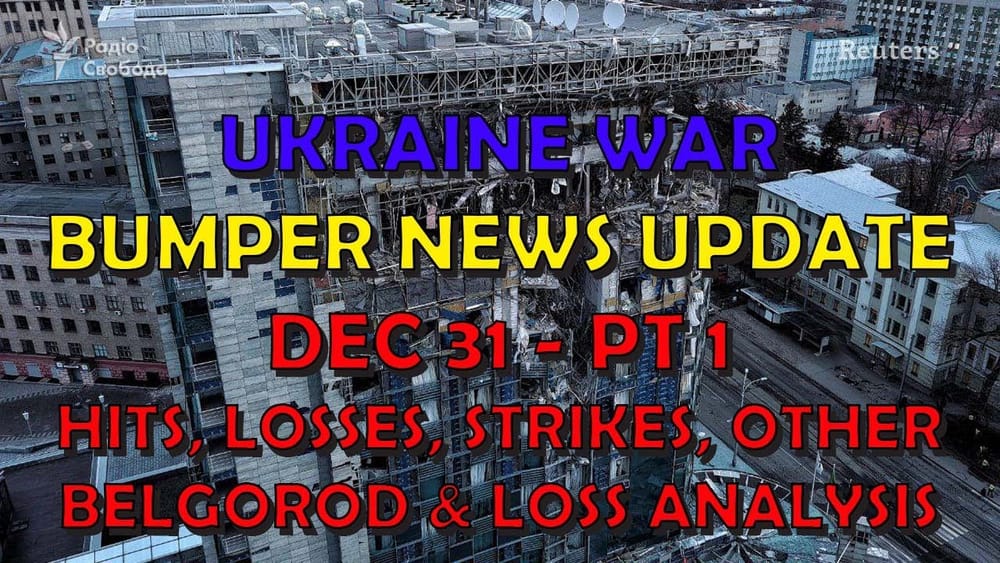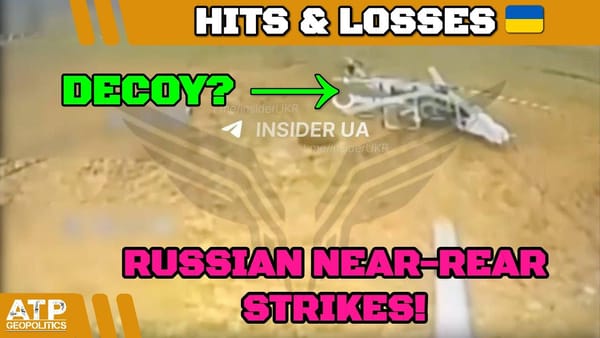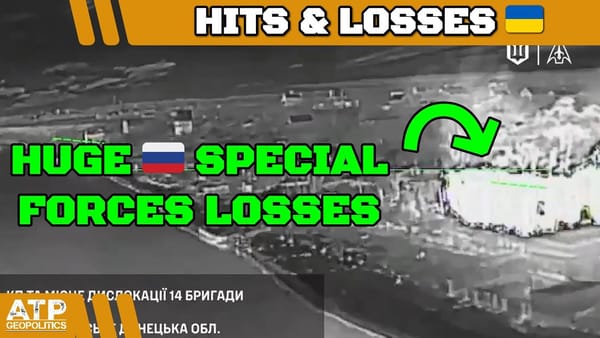Ukraine War Update BUMPER NEWS: Pt 1 - Overnight & Other News & Belgorod Analysis
Table of Contents 📖
"Ukraine should just let those missiles hit the targets. That's the best thing that Ukrainians can do. Don't bother trying to shoot them down because what goes up must come down."
Hello Team
🎦 00:00-00:14⏩
Jonathan welcomes viewers to the last Ukraine War News Update of 2023, reflecting on the year's geopolitical turmoil and expressing hope for peace in the coming year, though acknowledging the likelihood of continued conflict.
Return to top⤴️
🪦 DISCLAIMER FOR GENERAL STAFF LOSSES DATA
- These are real people with real lives and real families who love them. Don’t let the numbers sap your humanity.
- These numbers probably aren’t accurate but they’re the best we have and we don’t need them to be accurate to be indicative of patterns of activity.
- All losses are estimates. Losses cannot be counted with accuracy because of the conditions on the ground.
- Both sides would see it to be of their advantage to minimize their own losses maximize the other side’s losses.
- Neither side releases their losses but we have enough transparency from the Ukrainian side to have confidence in they are indicative.
- Personnel losses are hard to count. If a soldier gets injured, heals up, and returns to the front line only to get injured again, is that one loss or two? Also, how to deal with losses from PMC’s or soldiers fighting with RF from occupied territories?
- Equipment losses are hard to count. If an AA complex involves several parts and one part gets disabled, is that a loss, or a fraction of a loss? If a tank gets disabled, repaired, back into the fight, then disabled again, is that one lost tank or two?
- All recorded losses are vulnerable to multiple reporting. We have already seen numerous cases of multiple drones in the air reporting the same loss from different angles as multiple engagements.
- Losses are not always reported on the same day they occurred. It is frequent that drone losses are reported at least 24 hours after other terrestrial equipment losses. Certain losses may not be reported for days or weeks for military intelligence reasons.
Russian Military Losses
🎦 00:15-03:00⏩
Jonathan reviews the high Russian personnel losses (960) and discusses the significance of equipment losses, including tanks, armoured personnel carriers, and artillery systems, citing the potential impact of North Korean rocket supplies on Russian MLRS usage. He highlights the unsustainable nature of these losses for Russia in the long term.
Return to top⤴️
Andrew Perpetua's Confirmed Losses (from Socials)
🎦 03:00-05:48⏩
Jonathan analyses confirmed losses reported by Andrew Perpetua, noting a significant disparity favouring Ukraine (7 or 8 to 1). He details Ukrainian losses (a damaged M113 and a damaged Stryker) and Russian losses (surveillance equipment, artillery, tanks, infantry fighting vehicles, APCs, trucks and civilian vehicles), emphasising the cumulative impact of Russian losses.
Return to top⤴️
Suchomimus Analysis: Novo-Makalivka Equipment Losses
🎦 05:48-07:01⏩
Jonathan reviews Suchomimus's analysis of Russian equipment losses near Novo-Makalivka, highlighting the significant loss of 15 pieces of equipment along a short stretch of road, indicating a "graveyard of equipment." He compares similar situations in other towns, such as Sinkivka and Avdiivka, emphasizing the substantial overall losses faced by Russia.
Return to top⤴️
The Importance of Loss Ratios
🎦 07:01-07:51⏩
Jonathan argues that while Russia might be making territorial gains, their high casualty rates make these victories unsustainable in the long run. He suggests that while a grinding strategy might work with limitless resources, Russia’s finite capacity for replacing lost equipment and personnel makes this approach ultimately unsuccessful.
Return to top⤴️
Forbes Article: Russia's Unsustainable Losses in Avdiivka
🎦 07:51-13:50⏩
Jonathan discusses a Forbes article highlighting the effectiveness of US-supplied Bradley Fighting Vehicles in Ukrainian hands around Avdiivka. The article reports a 14 to 1 loss ratio in favour of Ukraine, emphasizing the unsustainable nature of Russian losses for a war of attrition. Jonathan notes the article's objective presentation of data, contrasting it with what he perceives as a pro-appeasement bias in recent New York Times reporting.
Return to top⤴️
Richard Vareka (Warspotting): Analysis of Russian Tank Losses
🎦 13:50-19:55⏩
Jonathan cites data from Richard Vareka (Warspotting) indicating a surge in confirmed Russian tank losses in December, exceeding any other month in 2023 except February and October. He examines a breakdown of tank losses by type, noting the prevalence of T-72s and T-80s and a shift toward more modern variants like the T-90M and T-80BVM. Jonathan suggests this data reveals a depletion of Russia’s readily available reserves, forcing them to rely on older, less capable equipment. He likens this trend to the decline in observed Russian BMP-1 losses, signifying a potential exhaustion of that particular model's reserves.
Return to top⤴️
Overnight Drone Attacks and Changing Tactics
🎦 19:55-22:58⏩
Jonathan discusses a recent wave of Shahed drone attacks, noting a lower-than-usual interception rate (less than 50%). He attributes this to a potential shift in Russian tactics, with drones now targeting frontline positions rather than cities. This change, Jonathan argues, challenges Ukrainian air defenses, which were previously configured to intercept drones primarily over urban areas. He suggests this adaptation demonstrates a degree of tactical ingenuity on the Russian side, exploiting vulnerabilities in Ukrainian defenses to increase the effectiveness of their drone attacks.
Return to top⤴️
Explosions in Belgorod: Conflicting Narratives
🎦 22:58-37:54⏩
Jonathan analyses explosions in Belgorod, examining conflicting narratives from Ukrainian and Russian sources. He details explosions in central Belgorod, initially attributed to falling debris from intercepted missiles by Russian authorities. However, this narrative shifted to accusations of Ukrainian shelling with Vilka MLRS and RM-70 Vampire missiles, claims disputed by Jonathan and open-source intelligence due to range limitations. He presents evidence suggesting some explosions were caused by high-explosive ordnance, while others might be attributable to shrapnel damage. Jonathan criticizes the New York Times for using images of Russian attacks in Ukraine to illustrate the Belgorod incident, further fueling confusion and potentially misrepresenting the situation.
Return to top⤴️
Russian Justification and Hypocrisy
🎦 37:54-40:56⏩
Jonathan dissects statements made by Russian UN representative Nebenzia, who argues that damage and casualties in Ukraine result from Ukrainian air defense systems rather than Russian strikes. Jonathan highlights the hypocrisy of this argument, contrasting it with Russia’s blaming of Ukraine for any damage caused by falling debris in Belgorod. He condemns Russia’s attempts to shift blame for civilian casualties onto Ukraine while simultaneously justifying attacks on Ukrainian infrastructure.
Return to top⤴️
Analysis of the Belgorod Incident
🎦 40:56-41:06⏩
Jonathan expresses skepticism of both Ukrainian and Russian narratives regarding the Belgorod explosions. While acknowledging the possibility of stray Ukrainian munitions or malfunctioning Russian air defense systems, he concludes that the true nature of the incident remains unclear.
Return to top⤴️
Russian Propaganda and the Reality of Liberation
🎦 41:06-43:45⏩
Jonathan criticizes Russian propaganda efforts, specifically highlighting a comic produced by the Russian Ministry of Defense portraying their troops in a positive light amidst the destruction of the Ukrainian town of Popasna. He juxtaposes this propaganda with drone footage depicting the town's utter devastation after two years of Russian occupation, emphasizing the hollowness of Russia's “liberation” narrative.
Return to top⤴️
Reflections on Desensitisation to Violence
🎦 43:45-46:35⏩
Jonathan shares his emotional response to a disturbing video circulating online depicting Russian soldiers torturing a mouse, expressing his discomfort and raising questions about the psychological effects of prolonged exposure to violence. He contrasts his reaction to the mouse’s suffering with his potentially desensitized response to human casualties, prompting reflection on the normalization of violence.
Return to top⤴️
Shebekino Border Incident
🎦 46:35-47:28⏩
Jonathan reports on alleged fighting in the Shebekino region near Belgorod, citing a Russian source claiming a Ukrainian incursion into Russian territory and mentioning unverified reports of US-made Abrams tanks operating in the area.
Return to top⤴️
Fundraising Update
🎦 47:28-48:12⏩
Jonathan celebrates the success of a fundraising campaign organized by The Greg Terry Experience, Professor Girkin's Explains, and ATP Geopolitics, which has raised over 100 000 USD to purchase drones, medical supplies, and other essential items for Ukrainian troops.
Return to top⤴️
Wrap Up
🎦 48:12-48:15⏩
Jonathan ends the update, acknowledging its length and bidding farewell to his audience.
Return to top⤴️



